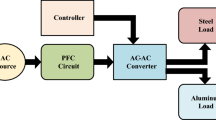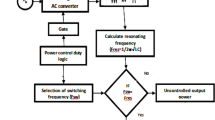Abstract
In this study, a new multi-output direct AC–AC converter is proposed. The proposed new converter consists of a combination of half-bridge (HB) and single-switch quasi-resonant (QR) topologies. In the proposed converter, the number of coils can be increased, all coils can be controlled independently, and independent power control can be made. The main problem of multi-output induction heating systems, such as the inability to increase the number of loads and to control the coils independently, has been eliminated with the proposed converter. The control of the converter is easy, cheap, and simple. The theoretical analysis of the proposed circuit is verified experimentally. In simulation and experimental studies, three coils were used at the output of the converter and each coil is designed to transfer 2000 W of power to the output. The proposed converter has been compared in detail with the conventional direct AC–AC converter in the same conditions. The new converter improves the performance and efficiency of induction heating systems.


























Similar content being viewed by others
References
Tanaka T (1989) A new induction cooking range for heating any kind of metal vessels. IEEE Trans Consum Electron 35(3):635–641. https://doi.org/10.1109/30.44329
Vishnuram P, Ramachandiran G, Ramasamy S, Dayalan S (2020) A comprehensive overview of power converter topologies for induction heating applications. Int Trans Electr Energ Syst. https://doi.org/10.1002/2050-7038.12554
Lucía O, Maussion P, Dede EJ, Burdío JM (2014) Induction heating technology and its applications: past developments, current technology, and future challenges. IEEE Trans Ind Electron 61(5):2509–2520. https://doi.org/10.1109/TIE.2013.2281162
Mishima T, Nakagawa Y, Nakaoka M (2015) A bridgeless BHB ZVS-PWM AC–AC converter for high-frequency induction heating applications. IEEE Trans Ind Appl 51(4):3304–3315. https://doi.org/10.1109/TIA.2015.2409177
Oncu S, Unal K, Tuncer U (2021) Laboratory setup for teaching resonant converters and induction heating. Eng Sci Technol. https://doi.org/10.1016/j.jestch.2021.05.016
Vishnuram P, Ramachandiran G, Babu T, Nastasi B (2021) Induction heating in domestic cooking and industrial melting applications: a systematic review on modelling, converter topologies and control schemes. Energies 14(20):6634
Vishnuram P, Ramachandiran G (2020) Capacitor-less induction heating system with selfresonant bifilar coil. Int J Circ Theor Appl 48(9):1411–1425. https://doi.org/10.1002/cta.2830
Sarnago H, Lucía O, Mediano A, Burdío JM (2014) A class-E direct AC–AC converter with multicycle modulation for induction heating systems. IEEE Trans Ind Electron 61(5):2521–2530. https://doi.org/10.1109/TIE.2013.2281164
Sarnago H, Lucía Ó, Mediano A, Burdío JM (2014) Direct AC–AC resonant boost converter for efficient domestic induction heating applications. IEEE Trans Power Electron 29(3):1128–1139. https://doi.org/10.1109/TPEL.2013.2262154
Park H, Kim M, Jung J, Kim H (2018) Load adaptive modulation method for all-metal induction heating application. IEEE Appl Power Electron Conf Expos 2018:3486–3490. https://doi.org/10.1109/APEC.2018.8341606
Sugimura H, Ahmed T, Orabi M, Lee HW, Nakaoka M (2004) Commercial utility frequency AC to high frequency AC soft switching power conversion circuit with non-smoothing DC link for IH dual packs heater. In: 30th Annual conference of IEEE industrial electronics society IECON 2004, pp 1155–1160. https://doi.org/10.1109/IECON.2004.1431738
Vishnuram P, Ramasamy S (2019) Fuzzy logic-based pulse density modulation scheme for mitigating uncertainties in AC–AC resonant converter aided induction heating system. J Circuits Syst Comput 58:66. https://doi.org/10.1142/S0218126619500300
Sarnago H, Lucia O, Burdío JM 2010 Multiple-output ZCS resonant inverter for multi-coil induction heating appliances. In: IEEE applied power electronics conference and exposition APEC2017, pp 2234–2238. https://doi.org/10.1109/APEC.2017.7931010
Forest F, Laboure E, Costa F, Gaspard JY (2000) Principle of a multi-load/single converter system for low power induction heating. IEEE Trans Power Electron 15(2):223–230. https://doi.org/10.1109/63.838094
Lucia O, Carretero C, Palacios D, Valeau D, Burdío JM (2011) Configurable snubber network for efficiency optimisation of resonant converters applied to multi-load induction heating. Electron Lett 47(17):989. https://doi.org/10.1049/el.2011.1711
Sugimura H, Mun SP, Kwon SK, Mishima T, Nakaoka M (2008) Direct AC–AC resonant converter using one-chip reverse blocking IGBT-based bidirectional switches for HF induction heaters. In: IEEE international symposium on industrial electronics, pp 406–412. https://doi.org/10.1109/ISIE.2008.4677043
Huang MS, Liao CC, Li ZF, Shih ZR, Hsueh HW (2021) Quantitative design and implementation of an induction cooker for a copper pan. IEEE Access 9:5105–5118. https://doi.org/10.1109/ACCESS.2020.3046713
Jeong SH, ** JI, Park HP et al (2022) Enhanced load adaptive modulation of induction heating series resonant inverters to heat various-material vessels. J Power Electron 22:1020–1032. https://doi.org/10.1007/s43236-022-00409-x
Han W, Chau KT, Liu W, Tian X, Wang H (2021) A dual-resonant topology-reconfigurable inverter for all-metal induction heating. IEEE J Emerg Sel Top Power Electron 66:21
Ramalingam SR, Boopthi CS, Ramasamy S, Ahsan M, Haider J (2021) Induction heating for variably sized ferrous and non-ferrous materials through load modulation. Energies 14:8354. https://doi.org/10.3390/en14248354
** J, Kim M, Han J et al (2020) Input voltage selection method of half-bridge series resonant inverters for all-metal induction heating applications using high turn-numbered coils. J Power Electron 20:1629–1637. https://doi.org/10.1007/s43236-020-00147-y
Jang E, Park SM, Joo D et al (2019) Analysis and comparison of topological configurations for all-metal induction cookers. J Electr Eng Technol 14:2399–2408. https://doi.org/10.1007/s42835-019-00292-w
Han W, Chau KT, Jiang C, Liu W (2018) All-metal domestic induction heating using single-frequency double-layer coils. IEEE Trans Magn 54(11):1–5. https://doi.org/10.1109/TMAG.2018.2846548
Sarnago H, Lucía O, Mediano A, Burdío JM (2014) Efficient and cost-effective ZCS direct AC–AC resonant converter for induction heating. IEEE Trans Ind Electron 61(5):2546–2555. https://doi.org/10.1109/TIE.2013.2262752
Sarnago H, Lucía Ó, Mediano A, Burdío JM (2013) Class-D/DE dual-mode-operation resonant converter for improved-efficiency domestic induction heating system. IEEE Trans Power Electron 28(3):1274–1285. https://doi.org/10.1109/TPEL.2012.2206405
Saha B, Kim R (2014) High power density series resonant inverter using an auxiliary switched capacitor cell for induction heating applications. IEEE Trans Power Electron 29(4):1909–1918. https://doi.org/10.1109/TPEL.2013.2265984
Ahmed NA, Nakaoka M (2006) Boost-half-bridge edge resonant soft switching PWM high-frequency inverter for consumer induction heating appliances. IEE Proc Electr Power Appl 153(6):932–938. https://doi.org/10.1049/ip-epa:20060086
Mishima T, Takami C, Nakaoka M (2014) A new current phasor-controlled ZVS twin half-bridge high-frequency resonant inverter for induction heating. IEEE Trans Ind Electron 61(5):2531–2545. https://doi.org/10.1109/TIE.2013.2274420
Sarnago H, Mediano A, Lucia Ó (2012) High efficiency AC–AC power electronic converter applied to domestic induction heating. IEEE Trans Power Electron 27(8):3676–3684. https://doi.org/10.1109/TPEL.2012.2185067
Forest F, Faucher S, Gaspard J, Montloup D, Huselstein J, Joubert C (2007) Frequency-synchronized resonant converters for the supply of multiwinding coils in induction cooking appliances. IEEE Trans Ind Electron 54(1):441–452. https://doi.org/10.1109/TIE.2006.888797
Vishnuram P, Ramasamy S, Sureshkumar A (2019) Phase-locked loop-based asymmetric voltage cancellation for the power control in dual half-bridge series resonant inverter sharing common capacitor for induction heating applications. J Control Autom Electr Syst 30:1094–1106. https://doi.org/10.1007/s40313-019-00515-5
Gomes RCM, Vitorino MA, Acevedo-Bueno DA, d. R Corrêa MB (2020) Multiphase resonant inverter with coupled coils for AC–AC induction heating application. IEEE Trans Ind Appl 56(1):551–560. https://doi.org/10.1109/TIA.2019.2955661
Lucía Ó, Burdío JM, Barragán LA, Acero J, Millán I (2010) Series-resonant multiinverter for multiple induction heaters. IEEE Trans Power Electron 25(11):2860–2868. https://doi.org/10.1109/TPEL.2010.2051041
Sarnago H, Burdío JM, Lucía Ó (2019) High-performance and cost-effective ZCS matrix resonant inverter for total active surface induction heating appliances. IEEE Trans Power Electron 34(1):117–125. https://doi.org/10.1109/TPEL.2018.2815902
Sarnago H, Guillén P, Burdío JM, Lucia O (2019) Multiple-output ZVS resonant inverter architecture for flexible induction heating appliances. IEEE Access 7:157046–157056. https://doi.org/10.1109/ACCESS.2019.2950346
Vishnuram P, Ramachandiran G (2021) A simple multi-frequency multiload independent power control using pulse density modulation scheme for cooking applications. Int Trans Electr Energ Syst 31:66. https://doi.org/10.1002/2050-7038.12771
Pérez-Tarragona M, Sarnago H, Lucía Ó, Burdío JM (2018) Design and experimental analysis of PFC rectifiers for domestic induction heating applications. IEEE Trans Power Electron 33(8):6582–6594. https://doi.org/10.1109/TPEL.2017.2755367
Saoudi M, Puyal D, Sarnago H, Antón D, Mediano A (2011) A new multiple coils topology for domestic induction cooking system. In: 14th European conference on power electronics and applications, pp 1–7
Burdio JM, Monterde F, Garcia JR, Barragan LA, Martinez A (2005) A two-output series-resonant inverter for induction-heating cooking appliances. IEEE Trans Power Electron 20(4):815–822. https://doi.org/10.1109/TPEL.2005.850925
Papani SK, Neti V, Murthy BK (2015) Dual frequency inverter configuration for multiple-load induction cooking application. IET Power Electron 8(4):591–601. https://doi.org/10.1049/iet-pel.2014.0114
Khatroth S, Shunmugam P (2020) Cascaded full-bridge resonant inverter configuration for different material vessel induction cooking. IET Power Electron 13(19):4428–4438. https://doi.org/10.1049/iet-pel.2020.0728
Lucia Ó, Carretero C, Burdio JM, Acero J, Almazan F (2012) Multiple-output resonant matrix converter for multiple induction heaters. IEEE Trans Ind Appl 48(4):1387–1396. https://doi.org/10.1109/TIA.2012.2199456
Sarnago H, Lucía Ó, Pérez-Tarragona M, Burdío JM (2016) Dual-output boost resonant full-bridge topology and its modulation strategies for high-performance induction heating applications. IEEE Trans Ind Electron 63(6):3554–3561. https://doi.org/10.1109/TIE.2016.2530780
Khatroth S, Shunmugam P (2021) Single-stage pulse frequency controlled AC–AC resonant converter for different material vessel induction cooking applications. Int J Circuits Theor Appl 66:1–20. https://doi.org/10.1002/cta.3042
Sarnago H, Lucía Ó, Mediano A, Burdío JM (2014) Design and implementation of a high-efficiency multiple-output resonant converter for induction heating applications featuring wide bandgap devices. IEEE Trans Power Electron 29(5):2539–2549. https://doi.org/10.1109/TPEL.2013.2278718
Gaudó PM, Bernal C, Avellaned J, Burdío JM (2012) Intermodulation distortion in 1SW-ZVS multi-inverter for induction heating home appliances. In: 2012 Twenty-seventh annual IEEE applied power electronics conference and exposition (APEC), pp 2223–2228. https://doi.org/10.1109/APEC.2012.6166131
Guillén P, Sarnago H, Burdío J (2020) Acoustic noise analysis of multiplexed strategies in multi-output converters for induction cooktops. Int J Appl Electromagn Mech 63(1):59–68. https://doi.org/10.3233/JAE-209115
Author information
Authors and Affiliations
Contributions
All authors read and approved the revised manuscript.
Corresponding author
Ethics declarations
Conflict of interest
The authors have no competing interests to declare that are relevant to the content of this article.
Additional information
Publisher's Note
Springer Nature remains neutral with regard to jurisdictional claims in published maps and institutional affiliations.
Rights and permissions
Springer Nature or its licensor (e.g. a society or other partner) holds exclusive rights to this article under a publishing agreement with the author(s) or other rightsholder(s); author self-archiving of the accepted manuscript version of this article is solely governed by the terms of such publishing agreement and applicable law.
About this article
Cite this article
Ozturk, M., Altintas, N. Multi-output AC–AC converter for domestic induction heating. Electr Eng 105, 297–316 (2023). https://doi.org/10.1007/s00202-022-01664-8
Received:
Accepted:
Published:
Issue Date:
DOI: https://doi.org/10.1007/s00202-022-01664-8




